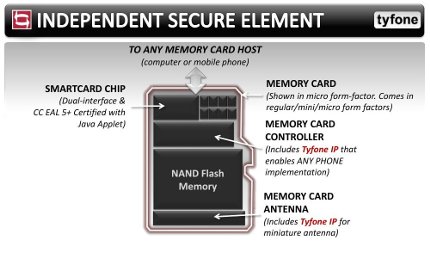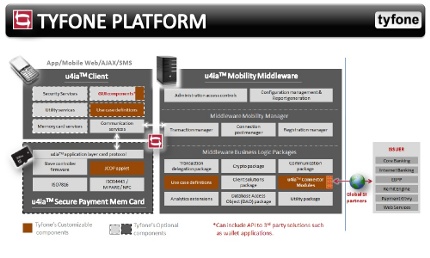The company’s patented technology allows an NFC secure element, controller and antenna to be built into SD and microSD cards, making it possible for mobile phone and PDA owners to add near field communication capabilities to their devices by just adding a Tyfone card.

The first field trials of Tyfone’s u4ia Secure Memory Card (SMC) technology are now expected to take place during the first half of this year, following successful internal testing at 21 organisations around the world and the completion of joint system testing with manufacturing partner NXP.
Tyfone’s u4ia (pronounced ‘euphoria’) has the potential to break the current handset availability problem by allowing any device with an SD memory card slot (micro, mini or regular) to have near field communication functionality added to it just by insertig a u4ia card. The firm says that 57% of current mobile phone models have a microSD slot and, beyond that, SD slots are commonly available in consumer electronics devices from cameras to PDAs and GPS receivers to games consoles.
The device also offers the potential for financial service providers — and others — to gain their own ‘real estate’ on a handset without needing to deal with a customer’s mobile network operator (MNO).
Tyfone’s U4ia secure memory card (SMC) contains:
- An industry standard, GlobalPlatform-compliant multi-application contactless smart card chip
- A memory card controller that includes Tyfone IP that enables the SMC to work with any SD slot equipped device
- A miniaturized antenna, developed by Tyfone
- Flash memory, available in standard SD and microSD card capacities (Tyfone’s NFC additions don’t reduce the size of memory available)

As well as the secure memory cards, Tyfone also provides a software platform that integrates into the issuer’s back office systems and manages the relationship between the client handset, the card and the issuer’s back end systems.

In an in-depth interview with Near Field Communications World, Tyfone’s Mike Feliciano explained that the company sees three main routes to market for its u4ia technology:
- Via a financial institution. Here, the customer would keep his existing SIM and his existing mobile contract and would simply insert a Tyfone SMC supplied by his bank or credit card issuer into his handset’s SD card slot. The financial institution, as owner of the SD ‘real estate’, would then seek to earn additional revenues by enabling other service providers to also offer services to the customer via the SD card.
- Via a mobile network operator, who would distribute secure memory cards to new and existing clients. Here, the key advantage would be that the MNO could begin to offer NFC-based services without the need to invest in replacing customers’ handsets with an NFC handset. It’s also possible that an MNO could generate additional profits by selling the SMCs to its customers at a premium.
- Via retail points-of sale where the cards could be sold directly to the customer, or could come preloaded with a retailer’s loyalty card programme or other services.
Key to the success of u4ia will be the performance of the miniaturized antenna and how robustly it works in a real world environment — something which the next phase of field testing is designed to discover. The first field trials will therefore take place in a closed loop environment, Feliciano told NFCW, where the company has full control over the whole system and can more easily identify and fix any issues that arise. The first small scale trial should begin during the first half of 2009 using SD cards and a microSD card trial will follow right away.
Tyfone then plans to go for open loop certification and to then run its first open loop pilot. “We still have work to do,” Feliciano admits, but “we anticipate having our first open loop field trial before the end of 2009.”
In volume, after launch, each u4ia card is expected to cost under US$10 plus the base cost of a memory card of the chosen capacity, says Feliciano.
There’s clear support for Tyfone’s approach from FSTC, the Financial Services Technology Consortium. “Clearly there is strong demand for the many benefits associated with NFC and the ‘mobile wallet’ paradigm,” says FSTC’s executive director Dan Schutzer. “While we support the GSMA’s call for industry standards and increased emphasis by handset manufacturers to provide integrated NFC capabilities, FSTC believes that Tyfone’s SD memory card secure element approach is a viable solution to accelerating the proliferation and adoption of NFC mobile payments on a global basis.”
Next: Visit the NFCW Expo to find new suppliers and solutions